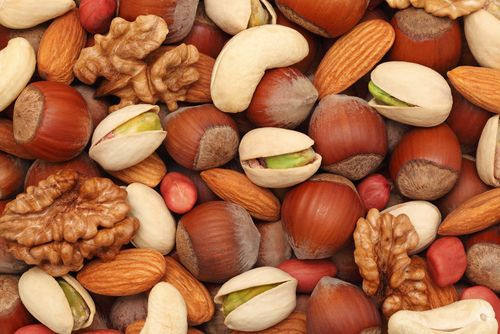National Nut Day 2014: Peanuts, Tree Nuts, And How Each Helps Your Health

Happy National Nut Day! Or, you know, happy Wednesday since nearly one out of every 10 Americans eats nuts or nut products. Though the purpose of this “holiday” isn’t just to increase a person’s prerogative to go HAM on a handful of almonds — it’s to remind them how healthy and versatile nuts are at all.
“For people who already eat plenty of meat and dairy products…nuts and ‘nutty’ legumes, like Brazil nuts, cashews, peanuts and walnuts, are a good nutritional alternative to meat,” Dr. Donal Murphy-Bokern, independent agri-environmental scientist and author of several studies on food system impacts, said in a statement. Heeding this advice means people can reap the benefits that come with eating nuts — Protein! Fiber! Omega-3 fatty acids! — at the same time they help the environment by reducing greenhouse gases. Scientific American reported meat production contributes up to 22 percent of the 36 billion tons of greenhouse gas emitted into the world each year.
Nuts fall into two categories: peanuts (which are really legumes) and tree nuts. The latter includes Brazil nuts, cashews, hazelnuts, macadamias, pecans, pine nuts, pistachios, walnuts and America’s beloved almonds. Health reported that each nut is “about equal in terms of calories per ounce, and in moderation, are all healthy additions to any diet.” And existing research generalizes that eating nuts does everything from reduce risk for a slew of diseases, maintains weight, boosts gastrointestinal and bone health, even adds years to a person’s life.
Yet, with so many available options (and nutritional profiles), do some nuts target specific areas of our health better than others? Does eating almonds and walnuts equally impact heart health? Or is it better to reach for pistachios? What about pecans? Cashews? We decided to crack open the case on the nuts to eat, and for what, in order to shell out the best advice. Sorry, nut puns are too much fun.
Weight Loss
Eat: Pistachios, almonds, and cashews
As previously mentioned, nuts are pretty much equal in terms of calories. There are, however, some nuts that have more heart-healthy nutrients and fats than others. See: pistachios. This particular tree nut is high in healthy fats called monounsaturated fats (MUFA). MUFAs are often associated with belly fat.
One study published in the journal Nutrition found that when middle-aged adults at risk for heart disease and diabetes incorporated more pistachios into their diet, they weighed less and lessened their cholesterol and blood sugar levels after just six months. And a separate study from UCLA found people who regularly ate pistachios lost an average of 10 to 12 pounds. Almonds and cashews are additional nuts high in MUFAs. While macademia nuts and pecans boast high levels of this fat, too, they are higher in calories and lower in protein.
How does a snack high in fat wind up being a tool for weight loss? A study in the American Journal of Clinical Nutrition concluded nut eaters tend to have healthier diets, replacing processed foods with nuts.
Heart Health
Eat: Walnuts
The Harvard School of Public Health reported, “several of the largest cohort studies, including the Adventist Study, the Iowa Women’s Health Study, the Nurses’ Health Study, and the Physicians’ Health Study have shown a consistent 30 percent to 50 percent lower risk of myocardial infarction, sudden cardiac death, or cardiovascular disease associated with eating nuts several times a week.”
Though almonds tend to be associated most with heart health, it’s actually walnuts that take the number one spot. The American Chemical Society presented research in 2011 that found walnuts have more antioxidants than other nuts, which work to protect cells against disease-causing free radicals. Dr. David Katz, the director of the Yale University Prevention Research Center, reviewed the findings for WebMD and revealed walnuts improve cardiac risk factors and enhance blood flow.
If that wasn’t convincing enough, Health reported a 2006 Spanish study, which “suggested that walnuts were as effective as olive oil at reducing inflammation and oxidation in the arteries after eating a fatty meal.” BOOM.
Brain Health
Eat: Peanuts, hazelnuts, and almonds
Folate, as defined by Harvard Medical School, is “the naturally occurring form of the vitamin that is in foods or in the blood.” It’s also the vitamin that staves off brain atrophy, or the progressive loss of brain cells over time. This means the more folate a person consumes, the better he or she can combat cognitive decline. A study published in the American Journal of Psychiatry found folate may ward off depression, too.
And which nut is super rich in folate? Unsalted peanuts. Brain HQ added peanuts are also high in vitamin E and niacin, both of which boost brain health. Hazelnuts and almonds are known to have concentrated amounts of E, too, so either nut is bound to help your noggin.
The bottom line: Nuts, when you're mindful of servings, can be extremely healthy, especially when you subtitute them for meat and fatty, processed foods. True, some are clearly better suited to cater to certain aspect's of a person's health, but the truth is, moderate servings of all and every nut will do no harm.



























